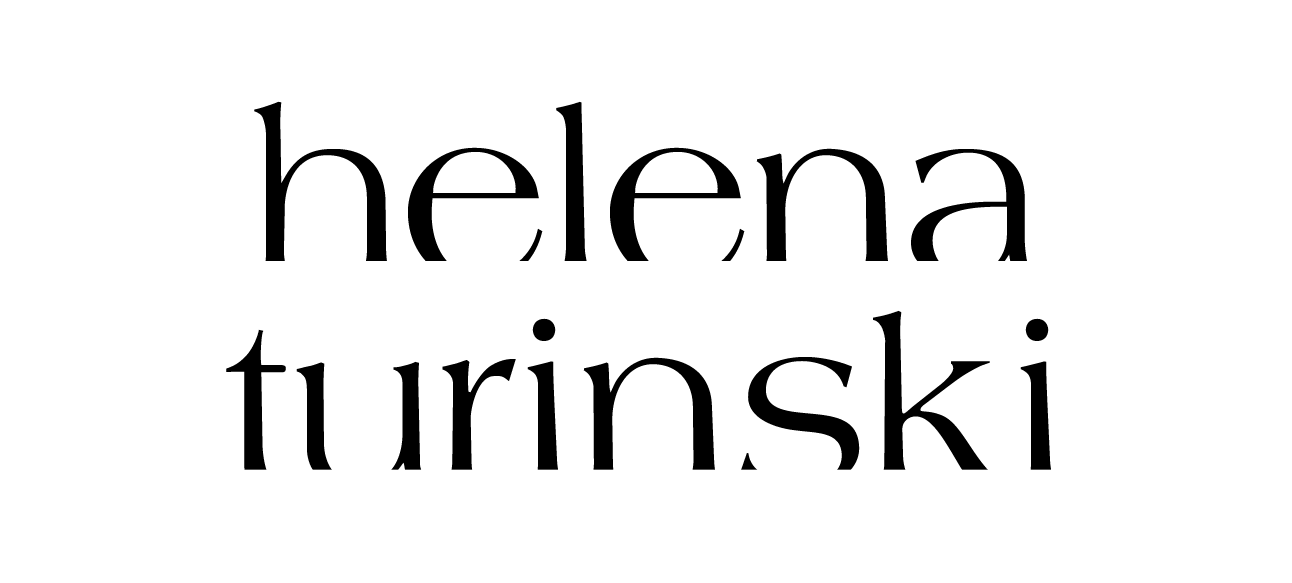Archive
- Behind the Screens 9
- Bright Young Things 16
- Colour Palette 64
- Dress Ups 60
- Fashionisms 25
- Fashionistamatics 107
- Foreign Exchange 13
- From the Pages of… 81
- G.U.I.L.T. 10
- Little Trifles 126
- Lost and Found 89
- Odd Socks 130
- Out of the Album 39
- Red Carpet 3
- Silver Screen Style 33
- Sit Like a Lady! 29
- Spin, Flip, Click 34
- Vintage Rescue 20
- Vintage Style 157
- Wardrobe 101 148
- What I Actually Wore 163
What is — and what is not — a fedora
THE DEFINITIVE GUIDE TO WHAT HAT IS THAT
 If you have been reading this blog for a little while, you will know that I love hats. While I am not a trained milliner, I do own a lot of hats (over 300) and books about hats, which I sometimes even read (as opposed to drooling over the pictures). I scour the internet for strange and wonderful hats, and for a long time I have been looking for the perfect 1930s or 1940s fedora. I already own one (pictured above), which I love for its film noir aspect, but I would love one more that has a more exaggerated shape, specifically in a colour I love (not black or brown, which are more ubiquitous).
If you have been reading this blog for a little while, you will know that I love hats. While I am not a trained milliner, I do own a lot of hats (over 300) and books about hats, which I sometimes even read (as opposed to drooling over the pictures). I scour the internet for strange and wonderful hats, and for a long time I have been looking for the perfect 1930s or 1940s fedora. I already own one (pictured above), which I love for its film noir aspect, but I would love one more that has a more exaggerated shape, specifically in a colour I love (not black or brown, which are more ubiquitous).
What I am finding however, is that vintage sellers seem to apply the word ‘fedora’ to any vaguely mannish hat, and I’m not sure if that’s because some of them aren’t really clear on the proper definition of a fedora, or because it is an extremely popular search term – I’ve seen it applied as a keyword for a frothy pink, flower-bedecked garden party hat! Today, however, I am going to clear up any misconceptions about what is – and what is not – a fedora, with a few key, easy-to-remember points to identify these same, same but different hats.
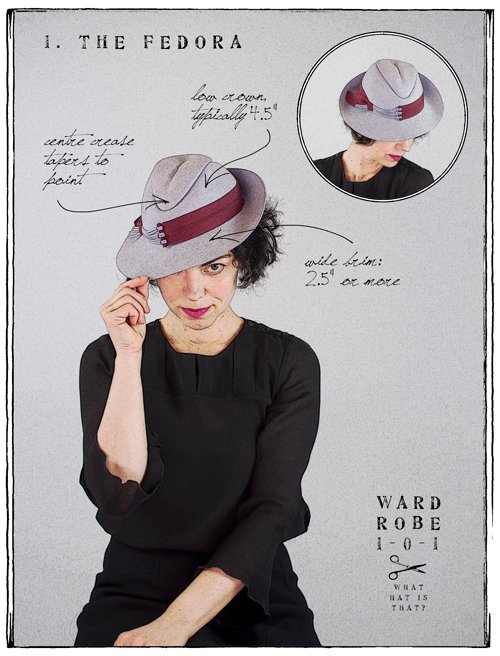 The Fedora
The Fedora
The fedora takes its name from an 1891 stage play, about a cross-dressing Princess Fedora who wears a centre-creased, soft wide-brimmed hat. Traditionally the crease is pinched at the front, forming a point or teardrop shape, but the crease can include diamond shaped crowns, and the positioning of dents can vary. Many other hats have centre dents, but the fedora combines this with a low crown – 4.5” or 11cm – and a wider brim of at least 2.5” or 6.4cm but they can be much wider, particularly in exaggerated fashion versions. The brims can be left raw, or stitched, or finished with ribbon-trim. This is the hat worn by Humphrey Bogart in the film Casablanca.
Key Points
- Low crown
- Centre crease pinched at front
- Wide brim
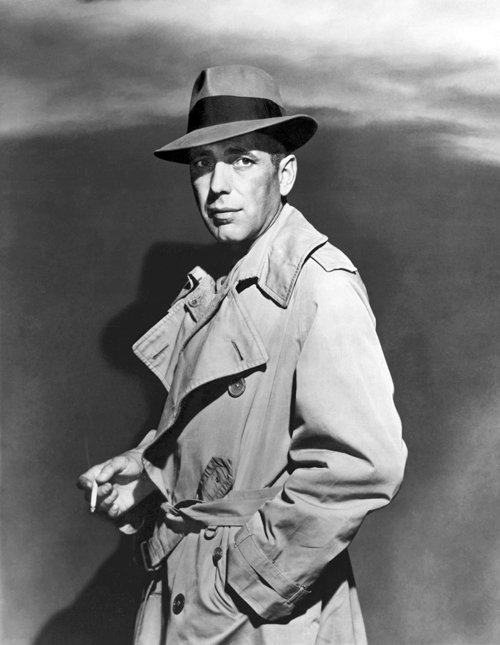 Humphrey Bogart in Casablanca; image found on Pinterest
Humphrey Bogart in Casablanca; image found on Pinterest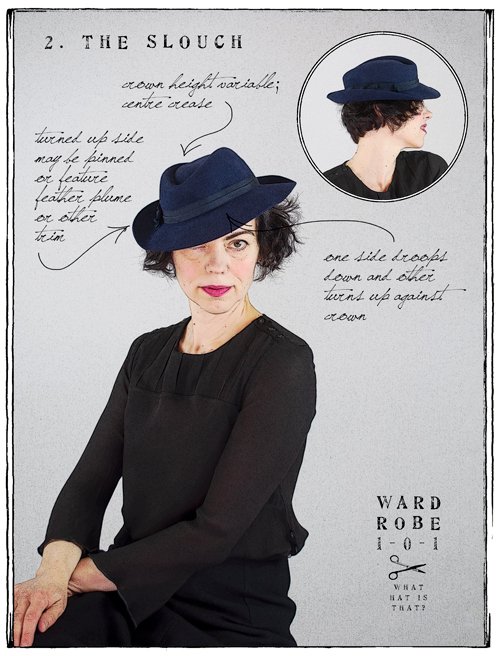
The Slouch
The next hat most commonly confused with a fedora, as far as I can discern, is the slouch hat. This is a style of hat traditionally worn by Australian soldiers (and those of many other nations), and is distinguished mainly with one side of the brim being turned up towards the crown, and one dipped down. The military hat has a fairly low crown, and the turned-up side is usually pinned to allow a rifle to be slung over the shoulder. Fashion versions vary in crown heights, but both feature a centre crease. Where the military hat is pinned up, the fashion hat may simply be decorated with trim on one side.
Key Points
- One side turned up, one side dipped down
- Crown height and brim width variable
- In place of the military pin, fashionable trim
 Australian soldier wearing a slouch in 1916; image found on Pinterest
Australian soldier wearing a slouch in 1916; image found on Pinterest
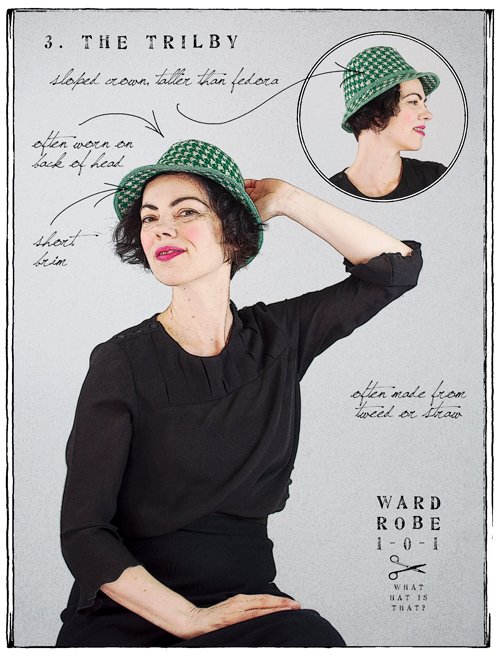 The Trilby
The Trilby
Another ubiquitous hat which can also be confused for a fedora is the trilby. Surprisingly, this is another hat whose inception lies in a stage play around the same time! George du Maurier’s 1894 novel Trilby was translated to the stage in London, and a hat of this shape was worn. Though the hat was worn by a woman, it became popular for men shortly after. It’s often made of tweed, like mine, or in straw for summer, though more properly its short brim is snapped up at the back. It has a much taller crown than a fedora, with sloped sides, and a popular hat with musicians, it is often worn on the back of the head. Sean Connery is well-known for wearing a trilby.
Key Points
- Short brim, usually snapped up at back
- Taller crown with sloping sides
- Designed to be worn further back on the head
 Sean Connery wearing a trilby; image found on Pinterest
Sean Connery wearing a trilby; image found on Pinterest
 The Homburg
The Homburg
The homburg is quite a masculine hat that has not really been translated into women’s versions, but this turquoise felt hat I own does not really fall into any other style, so I am using it to illustrate this style, perhaps most famously worn by Winston Churchill. Its most distinctive feature is the pencil-curled brim (which mine does not have at all). The hat is usually made of hard felt, with straight sides and a pronounced and quite wide centre crease. It is still a very popular hat shape for men today – and gangsters of all eras! Michael Corleone of The Godfather, and Nucky Thompson of Boardwalk Empire both present fine examples of the homburg’s sinister aspect.
Key Points
- Short, curled brim
- Taller crown with straight sides
- Wide, shallow centre crease
 Winston Churchill was famous for his homburg; image found on Pinterest
Winston Churchill was famous for his homburg; image found on Pinterest
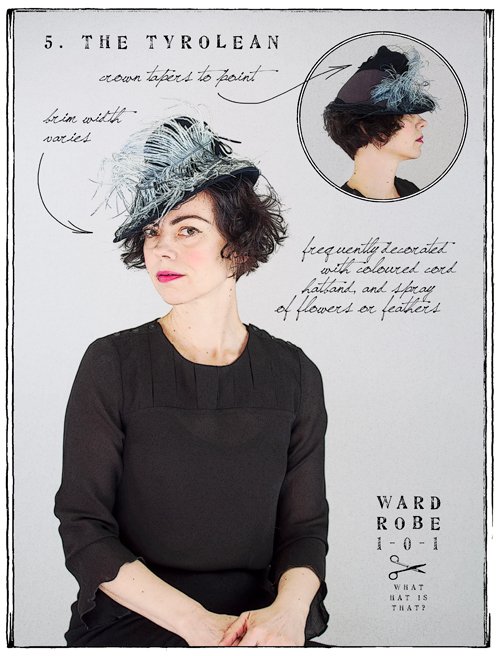
The Tyrolean
The Tyrolean hat style is one of my favourite jaunty styles! It originates from the Tyrol in the Alps, in what is now variously Austria, Germany, Italy and Switzerland. Its most distinctive feature is the crown that rises to form a point. The brim traditionally was roughly the width of a hand, and the hat was usually decorated with hatband made of coloured cord and a spray of flowers, feathers or brush. However, brims and crown heights varied in different parts of the Tyrol. Also known as a Bavarian or Alpine hat, it was originally made from green felt. Fortunately, fashion versions are not so limited in scope. Mine is navy, trimmed in a wide grosgrain band, netting, and a light blue ostrich feather. Edward VIII stayed in Austria after his abdication and often wore the hat, popularising its style.
Key Points
- Crown tapers to a point
- Crown height and brim width varies
- Decorated with flowers or feathers
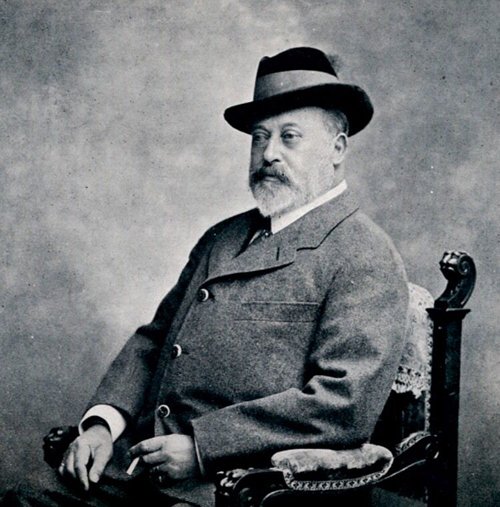 Edward VIII made the Tyrolean hat famous after his abdication
Edward VIII made the Tyrolean hat famous after his abdication
In Conclusion
Of course, it must be remembered that these key points are only guidelines for identifying a general style – they are not hard and fast rules. Fashion hats often take inspiration from traditional styles and designers will add their own twist, pushing and pulling them in exaggerated directions, creating hybrids with brilliant details and wonderful new ideas. A hat should be the exclamation point of an outfit, the finishing touch to delight the eye – much more than a conservative tradition. But it’s always good to know the rules before you break them.
Photos: September 2019
The Tie Cuff
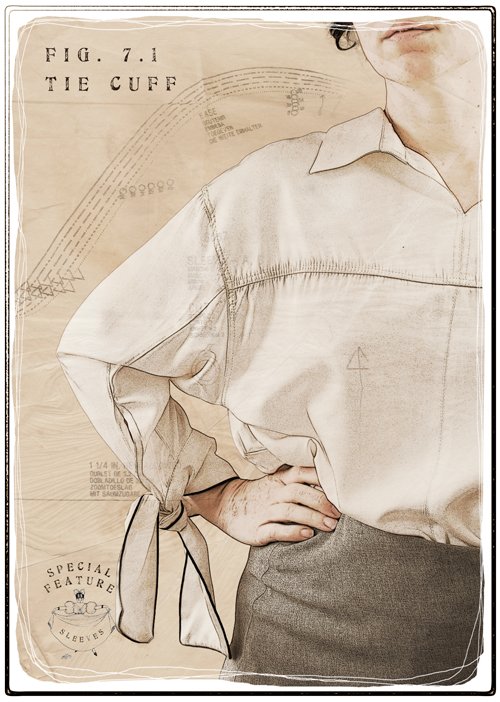
Long cuffs that fasten with a knot or bow, or ‘tie cuffs’ as I have dubbed them, add a decorative element to what may be an otherwise ordinary sleeve. But if you have never sported a tie cuff, be warned: unsuspected dangers lurk in these knotty waters!
The dropped shoulder of this long sleeve belongs to a rather dramatic, billowy blouse that features very large and long tie cuffs. The first time I wore this blouse I immediately knew why I had found it at the thrift store. While the fabric is soft, it is quite substantial, and the cuff takes the form of long, wide ties, accentuated by black piping, that are knotted at the wrist. As the sleeves are quite wide too, I took care to knot them so that the ties fell on the outside of the hand.
The ties were disconcerting at first, a hindrance until I allowed gravity to drag at the weight of the knots to keep them out my way while using my computer keyboard at work. I also discovered another hazard at lunchtime: because of the heavy, floppy ties, I managed to splash a bit of my curry laksa soup on the cuff (fortunately I was able to wash it out). This blouse is clearly for those who thumb their nose at sartorial danger, and it was admired by my work colleagues.

… if you have never sported a tie cuff, be warned: unsuspected dangers lurk in these knotty waters!
Three-quarter sleeves, such as on this striped blouse with its set-in sleeves, are a more sensible design choice combined with dangling tie cuffs. This cotton fabric (adorably striped like traditional ticking, which I love) is much lighter as well, so the ties pose no danger.
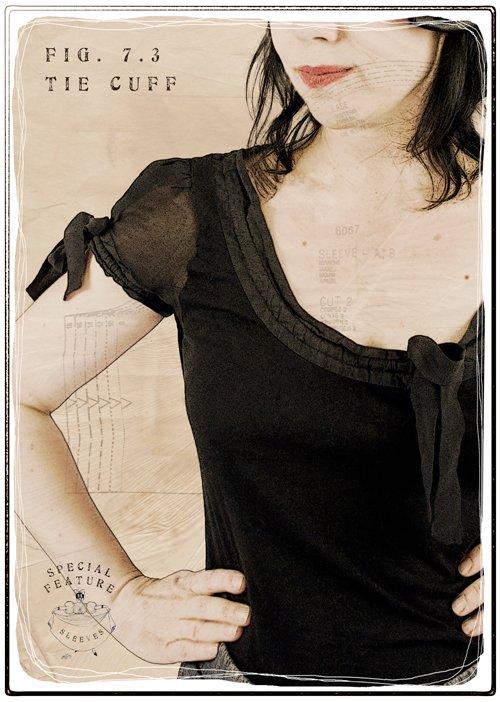
The puff sleeves, also set-in, of this cotton modal and silk tee have silk chiffon ties – lighter still – which are long and thin enough to tie into bows: both decorative and too short to interact perilously with the environment. An asymmetrically-placed bow at the neckline combined with the two sleeve bows create a pretty and overtly feminine top.
Three styles of tie-cuffs, three very different effects with various danger levels: from big drama, to breezy and casual, to whimsical femininity.
Review all the sleeves in the gallery thus far.
Roll-Up, Roll-Up!
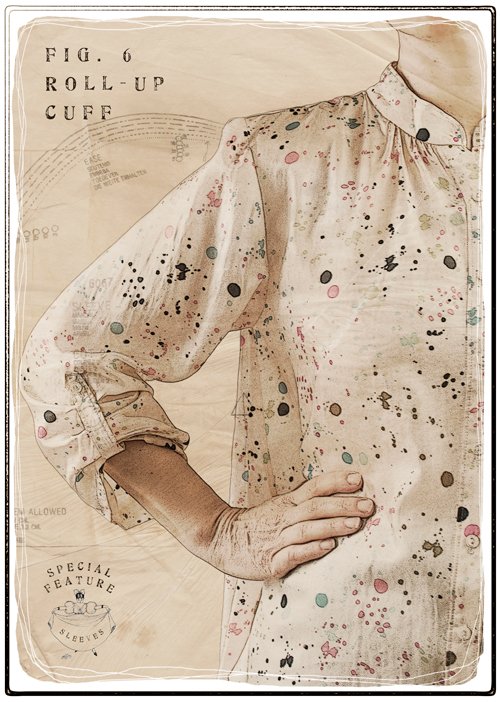 Another type of cuffed sleeve is the classic roll-up. A tab on the inside of a long sleeve attaches to a button on the exterior when the sleeve is rolled up. Depending on the stiffness of the fabric, one can neatly fold it (literally roll it up) or simply gather it and allow it to fall in natural folds as I have done in this example.
Another type of cuffed sleeve is the classic roll-up. A tab on the inside of a long sleeve attaches to a button on the exterior when the sleeve is rolled up. Depending on the stiffness of the fabric, one can neatly fold it (literally roll it up) or simply gather it and allow it to fall in natural folds as I have done in this example.
This cuff should not be confused with the dressy cuff often seen on more formal sleeves and pant legs (both shorts and full-length trousers). Unlike the roll-up, which reveals the seam, this cuff is decorative, created from a separate piece of fabric and attached with the front side of the fabric facing outwards.
The roll-up is a casual sleeve, but also quite practical when you need to get your hands dirty. My silk smock blouse takes that concept to the nth degree with a paint splatter print!
Review all the sleeves in the gallery thus far.
The Cuffed Sleeve
 One of the most basic sleeve styles is the cuffed sleeve. The cuff can take many forms, from the familiar ‘man’s shirt’ sleeve cuff, to simple band or piping cuffs.
One of the most basic sleeve styles is the cuffed sleeve. The cuff can take many forms, from the familiar ‘man’s shirt’ sleeve cuff, to simple band or piping cuffs.
This first cuff (above) is a band cuff that fastens with a single button in a narrower variation on the standard shirt cuff. It has pleats on either side of the button and a short placket opening that enables the hand to slide through.
Band cuffs without fastenings at the wrist are of course loose enough to allow the hand to slip through – piping cuffs are a very narrow type of cuff in this style – while band cuffs on the upper arm (such as on short puffed sleeves) often don’t have fastenings.
 Another variation in the man’s shirt cuff is the French cuff, which is doubled in length and folded back. On a man’s shirt, cufflinks are used to fasten the two ends together. This is a more formal shirt worn with a suit by groomsmen or high-powered businessmen for a very debonair look. My silk gingham shirt has French cuffs that are simply folded back with the ends left loose – a contrast with the informal sash tie at the waist.
Another variation in the man’s shirt cuff is the French cuff, which is doubled in length and folded back. On a man’s shirt, cufflinks are used to fasten the two ends together. This is a more formal shirt worn with a suit by groomsmen or high-powered businessmen for a very debonair look. My silk gingham shirt has French cuffs that are simply folded back with the ends left loose – a contrast with the informal sash tie at the waist.
 A more interesting type of cuff is the multi-buttoned style. These cuffs are usually quite fitted. I am wearing a silk blouse with four-button cuffs, but two-button cuffs are more common to see. In the Victorian era, very long, fitted, buttoned cuffs up to the elbow were a popular style, and were usually topped with a blouson shoulder. This type of sleeve is called a gigot – French for the back leg of an animal, a prettier name than ‘leg of mutton’ – or even Gibson Girl sleeves after the Victorian era archetype, who wore gigot sleeves on the classic pigeon-breasted blouses – we’ll visit those as soon as I find one to add to my wardrobe!
A more interesting type of cuff is the multi-buttoned style. These cuffs are usually quite fitted. I am wearing a silk blouse with four-button cuffs, but two-button cuffs are more common to see. In the Victorian era, very long, fitted, buttoned cuffs up to the elbow were a popular style, and were usually topped with a blouson shoulder. This type of sleeve is called a gigot – French for the back leg of an animal, a prettier name than ‘leg of mutton’ – or even Gibson Girl sleeves after the Victorian era archetype, who wore gigot sleeves on the classic pigeon-breasted blouses – we’ll visit those as soon as I find one to add to my wardrobe!
Refresh your sleeve knowledge by visiting the gallery for the whole set so far.
The Luxury Hat
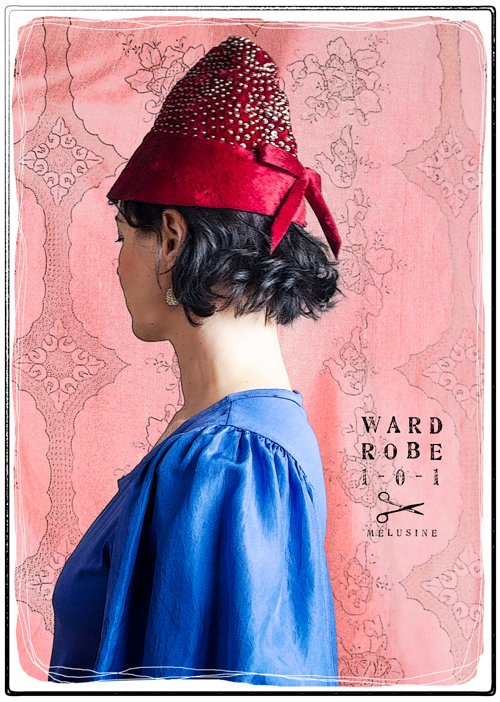 Felt is an ancient fabric, and perhaps the first made by man: it is made rather easily as it is not woven and does not require a loom. According to legend, in the Middle Ages a wandering monk named St Clement – destined to become the fourth bishop of Rome – happened upon the process of felt-making quite by accident. It is said that to make his shoes more comfortable, he stuffed them with tow (short flax or linen fibres). Walking in them on damp ground, he discovered that his own weight and sweaty feet had matted the tow fibres together into a kind of cloth. After being made bishop (with the power to indulge his whimsy), he set up a workshop to develop felting production … and thus he became the patron saint for hatmakers, who of course use felt to this day.
Felt is an ancient fabric, and perhaps the first made by man: it is made rather easily as it is not woven and does not require a loom. According to legend, in the Middle Ages a wandering monk named St Clement – destined to become the fourth bishop of Rome – happened upon the process of felt-making quite by accident. It is said that to make his shoes more comfortable, he stuffed them with tow (short flax or linen fibres). Walking in them on damp ground, he discovered that his own weight and sweaty feet had matted the tow fibres together into a kind of cloth. After being made bishop (with the power to indulge his whimsy), he set up a workshop to develop felting production … and thus he became the patron saint for hatmakers, who of course use felt to this day.
 Parisian costume, 1826
Parisian costume, 1826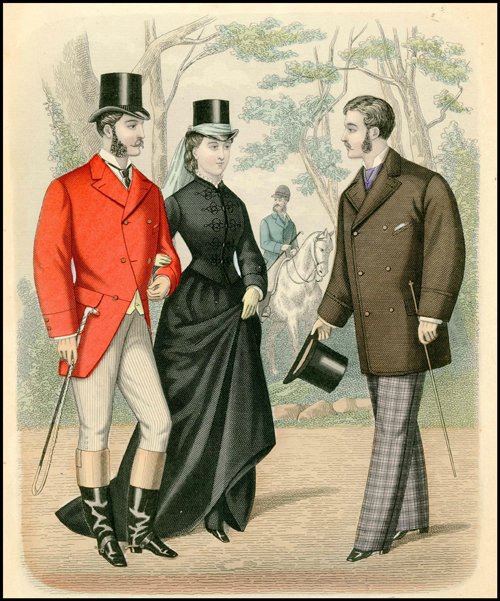 Men and women’s beaver top hats, Gentleman’s Magazine of Fashion, 1876Today most felt is made of wool, but in the past, animal fur was used to make a high-quality felt. Animal fur has tiny, microscopic spines which lock together much like Velcro when heat and moisture are applied. Beaver was the superior fur because its spines were prominent and helped produce a high-quality felt; hats made from it date back to at least the sixteenth century, and they were a staggeringly expensive luxury item. Naturally, to reduce the cost of fur felt, other furs were used such as rabbit or hare, camel, and angora (mohair).
Men and women’s beaver top hats, Gentleman’s Magazine of Fashion, 1876Today most felt is made of wool, but in the past, animal fur was used to make a high-quality felt. Animal fur has tiny, microscopic spines which lock together much like Velcro when heat and moisture are applied. Beaver was the superior fur because its spines were prominent and helped produce a high-quality felt; hats made from it date back to at least the sixteenth century, and they were a staggeringly expensive luxury item. Naturally, to reduce the cost of fur felt, other furs were used such as rabbit or hare, camel, and angora (mohair).
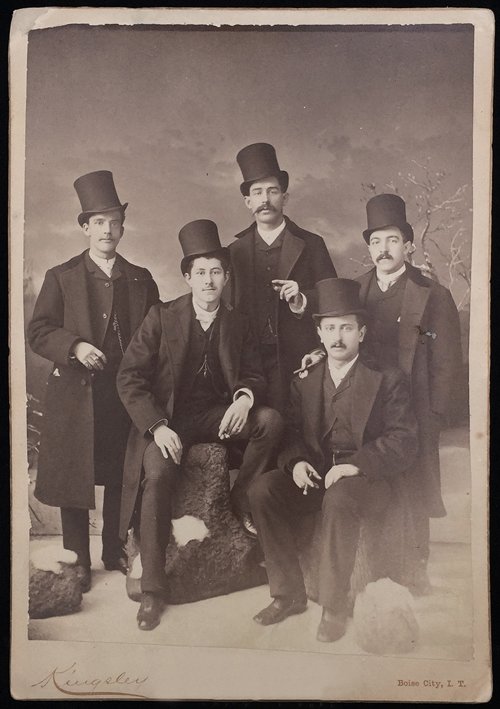 Men wearing beaver hats, 1886But it was another type of hat altogether that toppled the beaver from its luxury perch at last: the silk top hat. First invented in 1797 and scandalising the general public with its fearsome appearance, by the mid nineteenth century, the silk top hat cost half the price of beaver, and overtook it in popularity owing to changes in lifestyle which meant the hardy fur felt hats were not needed.
Men wearing beaver hats, 1886But it was another type of hat altogether that toppled the beaver from its luxury perch at last: the silk top hat. First invented in 1797 and scandalising the general public with its fearsome appearance, by the mid nineteenth century, the silk top hat cost half the price of beaver, and overtook it in popularity owing to changes in lifestyle which meant the hardy fur felt hats were not needed.
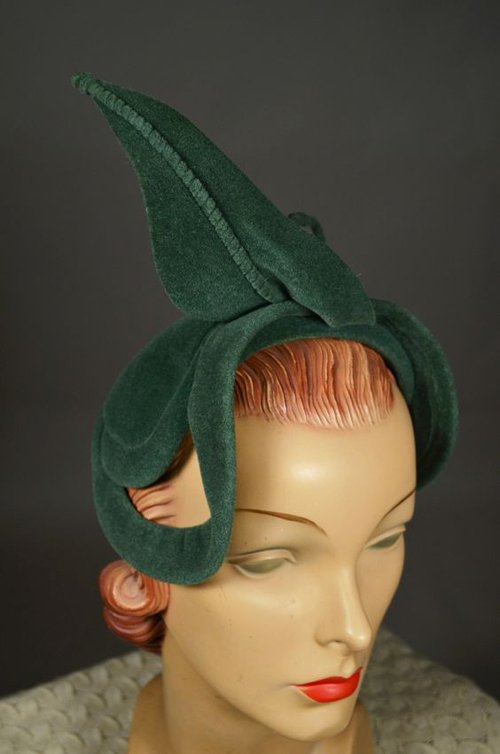 50s hat of angora fur felt; authorised reproduction of a Claude Saint-Cyr designI was initially attracted to this red 1950s pixie hat because of its dramatic shape, and the pearls (which I love) sewn all over it. It is made with Melusine, a felt made from rabbit fur. Melusine has long, fine fibres that are brushed to create a silky long-haired finish. In the past I had presumed ‘fur felt’ was a misnomer, and that such fabric was actually made from wool to look like fur. I was a bit sad when I realised this hat was real rabbit fur; however, at least it is vintage and recycled.
50s hat of angora fur felt; authorised reproduction of a Claude Saint-Cyr designI was initially attracted to this red 1950s pixie hat because of its dramatic shape, and the pearls (which I love) sewn all over it. It is made with Melusine, a felt made from rabbit fur. Melusine has long, fine fibres that are brushed to create a silky long-haired finish. In the past I had presumed ‘fur felt’ was a misnomer, and that such fabric was actually made from wool to look like fur. I was a bit sad when I realised this hat was real rabbit fur; however, at least it is vintage and recycled.
 An amazing pink fur felt reproduction Regency hat, by Jane Walton, 2019I have a few other vintage hats also made from melusine, all from the 50s and 60s. While wool felt is certainly more common these days, you can still buy new fur felt hats (some sources nebulously state the fur is a ‘by-product’) – even top hats made from beaver that are worn by top cats at Ascot – and they are still quite expensive.
An amazing pink fur felt reproduction Regency hat, by Jane Walton, 2019I have a few other vintage hats also made from melusine, all from the 50s and 60s. While wool felt is certainly more common these days, you can still buy new fur felt hats (some sources nebulously state the fur is a ‘by-product’) – even top hats made from beaver that are worn by top cats at Ascot – and they are still quite expensive.
Photo: June 2019

